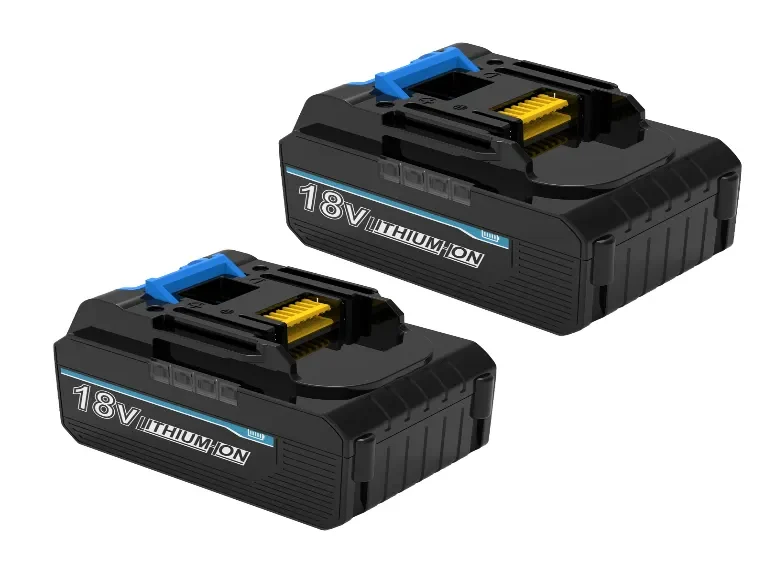Charging Best Practices to Maximize Makita Battery Cycles

Quick summary — 5 rules for maximum life
-
Always use the correct Makita/OEM charger.
-
Charge only within 5–40 °C (41–104 °F).
-
Favor partial top-ups (20–90%) over full charges for everyday use.
-
Use fast charge only when turnaround is urgent.
-
Store long-term at 30–50% SOC, in a cool, dry place.
This article explains why those rules matter and gives jobsite-ready checks, measurements, and rules-of-thumb you can apply today.
Why charging habits matter
Each charge cycle induces chemical and thermal stress inside lithium-ion cells. The three biggest drivers of aging are:
-
High-voltage stress (keeping a cell near 100% SOC too long),
-
Deep discharge stress (regularly running to 0%), and
-
Thermal stress (high charge or ambient temperatures).
Good charging habits reduce those stresses and increase usable cycles and retained capacity over years.
Before charging — quick pre-check (30–60 s)
-
Visual check: swelling, cracks, melted plastic, or odd odor → retire the pack.
-
Clean terminals with isopropyl alcohol and lint-free cloth; ensure charger bay is debris free.
-
Check ambient temperature: if <5 °C or >40 °C, warm/cool the pack first.
-
Verify pack/charger family (LXT vs CXT) and use the correct charger.
A 60-second habit here prevents most avoidable failures.
Habits to Extend Battery Life
1. Avoid extremes (SOC strategy)
-
Daily work: aim for partial charges — top up between 20% and 80–90% rather than always charging to 100%.
-
Why: high voltage stresses electrodes and accelerates calendar aging. Shallow cycles deliver more usable cycles than repeated full cycles.
Rule: charge to 80–90% for light tasks, 100% only if a full runtime is required — but don’t let it sit full for days.
2. Use fast charge sparingly
-
Fast charge is great for quick turnaround.
-
Tradeoff: repeated high-current charging adds heat and internal stress.
Rule: reserve fast charging for urgent jobs and rely on standard charging for daily use.
3. Respect temperature windows
-
Too cold (<5 °C / 41 °F): charging risks lithium plating — warm the pack first.
-
Too hot (>40 °C / 104 °F): charging may damage cells — cool it down first.
-
Overheat during charge (>45–50 °C): stop and quarantine.
Charging safety & monitoring
-
Place chargers on ventilated, non-flammable surfaces.
-
Monitor for overheating (>45–50 °C), odors, or persistent fault LEDs. Stop and quarantine if observed.
-
Avoid leaving packs charging unattended unless policy and certified equipment permit.
Long-term storage & care (short recap)
-
Store at 30–50% SOC in 15–25 °C, low humidity.
-
Inspect and top up every 3 months (monthly in extreme climates).
-
Don’t store at 100% or in very hot environments.
Cold-weather tips
-
Carry a warmed spare in an insulated pouch.
-
Pre-warm packs 30–60 minutes before charging or heavy use.
-
Respect charger cold-delay LEDs — they’re protecting the pack.
Monitoring battery health — simple metrics
Open-circuit voltage (OCV) quick reference
-
Makita LXT 18V (Li-ion): full OCV ≈ 20.0–21.6 V.
-
Makita CXT 12V (Li-ion): full OCV ≈ 12.4–12.8 V.
If OCV is well below expected after full charge, investigate (e.g., < ~17–18 V on 18V packs is a red flag).
Load-sag quick check
Example with 2 A load:
-
OCV = 20.00 V
-
V_load = 19.00 V
-
ΔV = 1.00 V → R_int = 0.500 Ω
Rule: sag ≤ ~1.0 V healthy; >2.0 V suggests aging and reduced capacity.
Signs a pack should be retired
-
Won’t hold charge after proper cycles.
-
Frequent BMS lockouts or charger rejection.
-
Swelling, leakage, burning smell.
-
Excessive heat or large voltage sag under light loads.
-
Measured capacity < 50–60% of rated.
When in doubt, quarantine and test.
Daily checklist (one-line flow)
Inspect → Warm/Cool → Clean terminals → Match charger → Partial top-up → Cool before reuse.
Short FAQ
Q: Does storing at 100% extend life?
No. Storing full accelerates aging. Use 30–50% for long-term.
Q: Is daily fast charging OK?
Occasional yes; daily fast charging shortens life.
Q: What if charger shows temp fault?
Warm/cool pack into spec and retry. If persists, quarantine.
Q: How many cycles can I expect?
Typically 500–1000 full cycles to ~80% capacity; best practices push toward higher end.
Conclusion — small habit, big ROI
By adjusting charging habits — safe temperatures, partial top-ups, sparing use of fast charge, and simple rotation — you extend cycle life, reduce replacement costs, and keep crews productive.